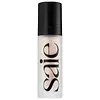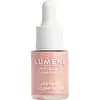Saie Glowy Super Gel Lightweight Dewy Highlighter Versus Lumene Invisible Illumination Instant Illuminizer
What's inside
What's inside
 Key Ingredients
Key Ingredients

 Benefits
Benefits

 Concerns
Concerns

 Ingredients Side-by-side
Ingredients Side-by-side

Water
Skin ConditioningCaprylic/Capric Triglyceride
MaskingPropanediol
SolventGlycerin
HumectantMica
Cosmetic ColorantHydroxyethyl Acrylate/Sodium Acryloyldimethyl Taurate Copolymer
Emulsion StabilisingSqualane
EmollientCaprylyl Glycol
EmollientPhenethyl Alcohol
MaskingEthylhexylglycerin
Skin ConditioningPolysorbate 60
EmulsifyingAscorbyl Tetraisopalmitate
AntioxidantCarica Papaya Seed Oil
HumectantRosa Canina Fruit Oil
EmollientLactic Acid
BufferingCI 77891
Cosmetic ColorantCI 77491
Cosmetic ColorantWater, Caprylic/Capric Triglyceride, Propanediol, Glycerin, Mica, Hydroxyethyl Acrylate/Sodium Acryloyldimethyl Taurate Copolymer, Squalane, Caprylyl Glycol, Phenethyl Alcohol, Ethylhexylglycerin, Polysorbate 60, Ascorbyl Tetraisopalmitate, Carica Papaya Seed Oil, Rosa Canina Fruit Oil, Lactic Acid, CI 77891, CI 77491
Water
Skin ConditioningC13-15 Alkane
SolventCaprylyl Methicone
Skin ConditioningLauryl PEG-10 Tris(Trimethylsiloxy)Silylethyl Dimethicone
EmulsifyingButylene Glycol
HumectantIsododecane
EmollientDimethicone
EmollientMica
Cosmetic ColorantRubus Chamaemorus Fruit Juice Extract
HumectantEpilobium Angustifolium Extract
Skin ConditioningRubus Chamaemorus Seed Extract
Skin ConditioningPhenoxyethanol
PreservativePolysilicone-11
Disteardimonium Hectorite
StabilisingPolyglyceryl-3 Diisostearate
EmulsifyingMagnesium Sulfate
Sodium Chloride
MaskingPropanediol
SolventTocopheryl Acetate
AntioxidantPropylene Carbonate
SolventTocopherol
AntioxidantGlycerin
HumectantEthylhexylglycerin
Skin ConditioningGlycine Soja Oil
EmollientHelianthus Annuus Seed Oil
EmollientPhenethyl Alcohol
MaskingSodium Carrageenan
Emulsion StabilisingTin Oxide
AbrasiveTriethoxycaprylylsilane
Maris Sal
Skin ConditioningSodium Benzoate
MaskingPotassium Sorbate
PreservativeCitric Acid
BufferingLinalool
PerfumingCitronellol
PerfumingParfum
MaskingCI 77491
Cosmetic ColorantCI 77891
Cosmetic ColorantWater, C13-15 Alkane, Caprylyl Methicone, Lauryl PEG-10 Tris(Trimethylsiloxy)Silylethyl Dimethicone, Butylene Glycol, Isododecane, Dimethicone, Mica, Rubus Chamaemorus Fruit Juice Extract, Epilobium Angustifolium Extract, Rubus Chamaemorus Seed Extract, Phenoxyethanol, Polysilicone-11, Disteardimonium Hectorite, Polyglyceryl-3 Diisostearate, Magnesium Sulfate, Sodium Chloride, Propanediol, Tocopheryl Acetate, Propylene Carbonate, Tocopherol, Glycerin, Ethylhexylglycerin, Glycine Soja Oil, Helianthus Annuus Seed Oil, Phenethyl Alcohol, Sodium Carrageenan, Tin Oxide, Triethoxycaprylylsilane, Maris Sal, Sodium Benzoate, Potassium Sorbate, Citric Acid, Linalool, Citronellol, Parfum, CI 77491, CI 77891
 Reviews
Reviews

Ingredients Explained
These ingredients are found in both products.
Ingredients higher up in an ingredient list are typically present in a larger amount.
Ci 77491 is also hydrated iron III oxide. It's sole purpose is to give a red/pink hue to products.
Iron III oxides are classified as inorganic chemicals for coloring.
Synthetically created Ci 77491 is considered safer than those naturally found. This is because the synthetically created version may contain less impurities. Iron oxides are generally non-toxic and non-allergenic.
Learn more about CI 77491Ci 77891 is a white pigment from Titanium dioxide. It is naturally found in minerals such as rutile and ilmenite.
It's main function is to add a white color to cosmetics. It can also be mixed with other colors to create different shades.
Ci 77891 is commonly found in sunscreens due to its ability to block UV rays.
Learn more about CI 77891Ethylhexylglycerin (we can't pronounce this either) is commonly used as a preservative and skin softener. It is derived from glyceryl.
You might see Ethylhexylglycerin often paired with other preservatives such as phenoxyethanol. Ethylhexylglycerin has been found to increase the effectiveness of these other preservatives.
Glycerin is already naturally found in your skin. It helps moisturize and protect your skin.
A study from 2016 found glycerin to be more effective as a humectant than AHAs and hyaluronic acid.
As a humectant, it helps the skin stay hydrated by pulling moisture to your skin. The low molecular weight of glycerin allows it to pull moisture into the deeper layers of your skin.
Hydrated skin improves your skin barrier; Your skin barrier helps protect against irritants and bacteria.
Glycerin has also been found to have antimicrobial and antiviral properties. Due to these properties, glycerin is often used in wound and burn treatments.
In cosmetics, glycerin is usually derived from plants such as soybean or palm. However, it can also be sourced from animals, such as tallow or animal fat.
This ingredient is organic, colorless, odorless, and non-toxic.
Glycerin is the name for this ingredient in American English. British English uses Glycerol/Glycerine.
Learn more about GlycerinMica is a naturally occurring mineral used to add shimmer and color in cosmetics. It can also help improve the texture of a product or give it an opaque, white/silver color.
Serecite is the name for very fine but ragged grains of mica.
This ingredient is often coated with metal oxides like titanium dioxide. Trace amounts of heavy metals may be found in mica, but these metals are not harmful in our personal products.
Mica has been used since prehistoric times throughout the world. Ancient Egyptian, Indian, Greek, Roman, Aztec, and Chinese civilizations have used mica.
Learn more about MicaPhenethyl Alcohol is a colorless and aromatic alohol. It is naturally occuring in essential oils.
The scent of this ingredient is floral and often compared to rose.
Like other alcohols, this ingredient helps prevent the growth of bacteria. However, its main purpose is to impact a fragrance.
Learn more about Phenethyl AlcoholPropanediol is an all-star ingredient. It softens, hydrates, and smooths the skin.
It’s often used to:
Propanediol is not likely to cause sensitivity and considered safe to use. It is derived from corn or petroleum with a clear color and no scent.
Learn more about PropanediolWater. It's the most common cosmetic ingredient of all. You'll usually see it at the top of ingredient lists, meaning that it makes up the largest part of the product.
So why is it so popular? Water most often acts as a solvent - this means that it helps dissolve other ingredients into the formulation.
You'll also recognize water as that liquid we all need to stay alive. If you see this, drink a glass of water. Stay hydrated!
Learn more about Water